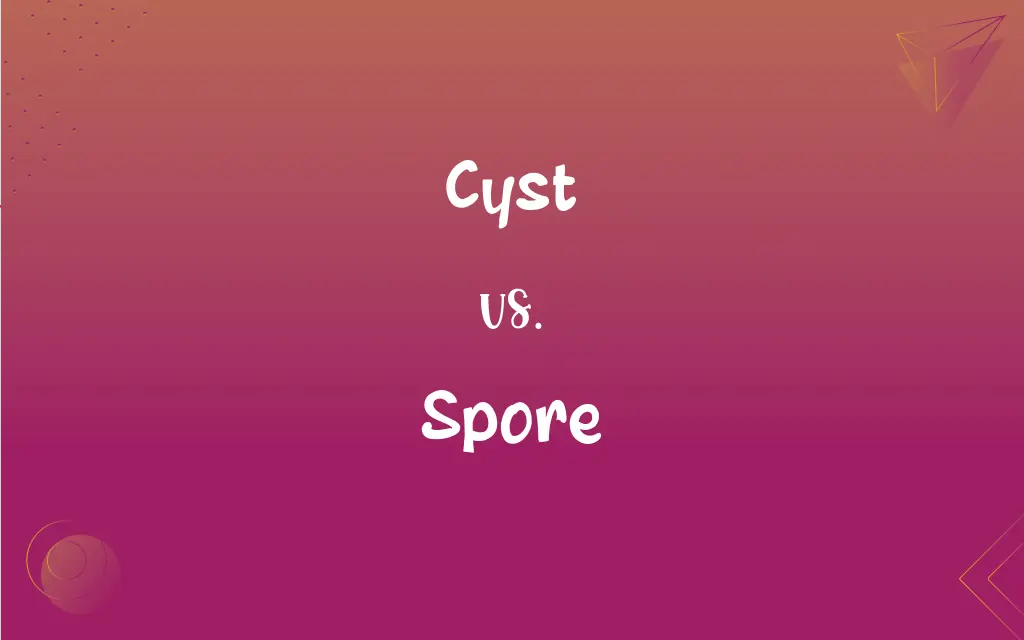Cyst vs. Spore: What's the Difference?
By Aimie Carlson & Harlon Moss || Published on October 11, 2024
Cysts are protective capsules for organism survival in harsh conditions; spores are reproductive units for spreading and growth.

Key Differences
Cysts and spores serve different biological functions. Cysts are dormant forms that protect the organism in adverse environments, ensuring survival by enclosing the organism in a resistant shell. Spores, however, are primarily involved in reproduction and dispersal, allowing for the spread of the species under favorable conditions.
Cysts are formed by some bacteria, protozoa, and certain animals as a survival mechanism against unfavorable conditions, spores are produced by bacteria, fungi, plants, and algae as a means of reproduction. This distinction highlights the survival versus reproductive roles of these structures.
The formation of a cyst typically involves the organism encapsulating itself to resist environmental stresses such as dehydration, temperature extremes, or chemical exposure. In contrast, spore formation is often a part of the organism's lifecycle, designed to ensure species propagation and survival through dispersal to new environments.
Cysts can revert back to their active form when conditions improve, resuming normal metabolism and growth. Spores germinate under favorable conditions, leading to the growth of a new organism. This reflects the adaptive strategies of different life forms to environmental challenges.
Both cysts and spores exhibit remarkable resistance to external conditions, but their purposes diverge significantly: one is for enduring dormancy and the other for ensuring the continuation and spread of life.
ADVERTISEMENT
Comparison Chart
Primary Function
Protection and survival in harsh conditions
Reproduction and dispersal
Formed By
Bacteria, protozoa, some animals
Bacteria, fungi, plants, algae
Role in Lifecycle
Dormancy phase for survival
Part of reproductive cycle
Environmental Trigger
Unfavorable conditions (e.g., dehydration)
Favorable conditions for growth
Outcome
Resumes active metabolism when conditions improve
Germinates into a new organism
ADVERTISEMENT
Cyst and Spore Definitions
Cyst
Found in various organisms for survival.
Certain parasites form cysts in the host body for protection.
Spore
A reproductive unit for dispersal and growth.
Mushroom spores are released to propagate the species.
Cyst
Encapsulates the organism to resist environmental stresses.
The protozoan forms a cyst to protect against chemicals.
Spore
Exhibits resistance to ensure survival until germination.
Spores can survive extreme conditions until they find suitable growth conditions.
Cyst
A protective capsule for survival in harsh conditions.
Amoebas form cysts to survive drought.
Spore
Leads to the growth of a new organism.
The spore germinates into a new plant under ideal conditions.
Cyst
Can revert to active form when conditions improve.
The cyst reverts to its active state once moisture returns.
Spore
Part of the organism's lifecycle for reproduction.
Bacterial spores ensure the bacteria's spread.
Cyst
Ensures organism survival through dormancy.
Cysts in soil ensure survival through winter.
Spore
Designed for species spread under favorable conditions.
Fern spores germinate in moist, shaded areas.
Cyst
An abnormal membranous sac in the body containing a gaseous, liquid, or semisolid substance.
Spore
A small, usually single-celled reproductive body that is resistant to adverse environmental conditions and is capable of growing into a new organism, produced especially by certain fungi, algae, protozoans, and nonseedbearing plants such as mosses and ferns.
FAQs
What is a spore?
A spore is a reproductive unit produced by certain organisms for dispersal and growth under favorable conditions.
How do cysts protect organisms?
Cysts encapsulate and protect the organism from dehydration, temperature extremes, and chemical exposure by going into a dormant state.
Can spores form in any environment?
While spores are resistant, their formation and successful germination typically require specific environmental conditions.
What is the difference between a cyst and a seed?
A cyst is a dormant cell with protective layers for survival, while a seed is a plant's reproductive unit containing an embryo and nutrients.
How do spores aid in reproduction?
Spores serve as reproductive units that can disperse and germinate under favorable conditions, leading to the growth of a new organism.
Do all bacteria form cysts?
No, not all bacteria form cysts. Cyst formation is specific to certain bacteria and other organisms as a survival strategy.
What is a cyst?
A cyst is a protective structure that organisms form to survive adverse environmental conditions.
Can cysts reproduce?
Cysts themselves are not reproductive structures; they are meant for survival. The organism within a cyst resumes normal growth or reproduction once it reverts to its active form.
Are spores resistant to harsh conditions?
Yes, spores are highly resistant to extreme conditions, enabling them to survive until they reach an environment suitable for germination.
What triggers spore formation in fungi?
Spore formation in fungi can be triggered by various factors, including nutritional depletion, changes in temperature, or the lifecycle phase of the fungus.
How do environmental conditions affect cyst formation?
Adverse conditions like dehydration or nutrient depletion trigger cyst formation as a survival mechanism.
Do cysts have a specific lifecycle phase?
Cyst formation usually occurs as a response to environmental stress rather than a specific phase in an organism's lifecycle.
What role do spores play in ecosystem diversity?
Spores facilitate the spread and diversification of species, contributing to ecosystem variety and resilience.
Can the formation of spores be controlled?
In some contexts, such as fermentation or laboratory cultures, the conditions that trigger spore formation can be controlled to some extent.
Can cysts be harmful to humans?
Some cysts formed by parasites can be harmful if they infect humans, leading to diseases.
Can both cysts and spores be found in the same organism?
Some organisms can produce both cysts and spores at different stages or for different purposes, though it's not common.
Are cysts always dormant?
Yes, cysts are typically dormant structures formed for survival during unfavorable conditions.
How are spores dispersed?
Spores can be dispersed by wind, water, or animals, depending on the organism and the type of spore.
How are cysts detected and studied?
Cysts can be detected through microscopic examination, staining techniques, and other diagnostic methods in various fields, including water treatment and medical diagnostics.
What scientific fields study spores?
Mycology, microbiology, and botany are among the fields that study spores and their roles in reproduction and survival.
About Author
Written by
Aimie CarlsonAimie Carlson, holding a master's degree in English literature, is a fervent English language enthusiast. She lends her writing talents to Difference Wiki, a prominent website that specializes in comparisons, offering readers insightful analyses that both captivate and inform.
Co-written by
Harlon MossHarlon is a seasoned quality moderator and accomplished content writer for Difference Wiki. An alumnus of the prestigious University of California, he earned his degree in Computer Science. Leveraging his academic background, Harlon brings a meticulous and informed perspective to his work, ensuring content accuracy and excellence.






































































